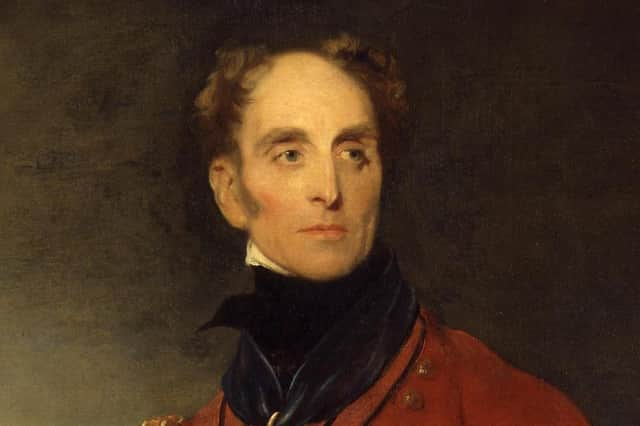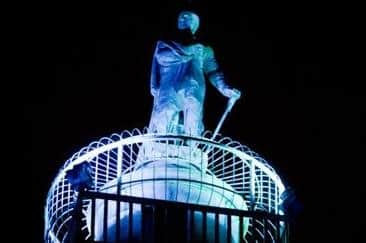Decorated soldier Sir Galbraith Lowry Cole missed Battle of Waterloo for his honeymoon


The Cole Memorial Column, a prominent feature of the Enniskillen skyline, was erected between 1845 and 1857 to commemorate General Sir Galbraith Lowry Cole, who, as commander of the 4th Division, was one of Wellington’s principal subordinates in the Peninsular War.
During the wars with France at the end of the 18th century Cole also served in the French West Indies, Martinique and Guadeloupe; the names of these and other battles in which he was involved are engraved on the base of the monument.
Advertisement
Hide AdAdvertisement
Hide AdUsually known as Lowry rather than Galbraith, Cole was a descendant of Captain William Cole, the ‘undertaker’ who had founded Enniskillen at the beginning of the 17th century. In 1760 one of his descendants, John Cole, became Baron Mount Florence and in 1789 his son, William Willoughby Cole, became the 1st Earl of Enniskillen.


Lowry Cole, born on May 1 1772 in Dublin, was the second son of the 1st Earl and Anne Lowry-Corry, the daughter of Galbraith Lowry-Corry of Tyrone and the sister of Armar Lowry-Corry, who became the 1st Earl of Belmore. It was the 1st Earl of Belmore who between 1790 and 1796 built Castle Coole, the classical mansion just south east of Enniskillen, to bolster his ambitious social and political pretensions. The latter came to nothing largely because of the Act of Union.
Lowry Cole enjoyed political and military careers and declined to maximise the opportunities afforded by a third, that of a colonial administrator. Cole’s impressive military career developed simultaneously alongside his much more modest political one, something which would not be possible today.
Lowry Cole was briefly MP for Enniskillen in the Irish Parliament between 1797 and 1800. Like many aristocratic and gentry families in Ulster, the Coles were hostile to the Union and so he voted against the proposed measure.
Advertisement
Hide AdAdvertisement
Hide AdAs serving officers were expected to vote with the administration, Cole was ordered abroad with his regiment. To prevent a by-election and election of an anti-Unionist candidate, the administration refused him the Escheatorship of Munster, a notional ‘office of profit under the crown’, appointment to which enabled Members of the Irish Parliament to resign after the Place Act of 1793.
Between 1803 and 1823 Cole was one of two MPs for Co Fermanagh in the United Kingdom Parliament. He succeeded his brother unopposed in 1803. His maiden speech on August 11 1803 was critical of the government’s handling of Robert Emmet’s abortive rising. In 1804 he was reckoned ‘against’ the government but ‘tied’ to Lord Enniskillen who was anxious to become a representative peer.
Cole’s military career began when he was commissioned a cornet in 12th Dragoons in March 1787. He first saw active service in Martinique where he was aide-de-camp to Sir Charles Grey. Between 1797 and 1800 he was deputy adjutant-general and ADC to Lord Carhampton, the commander-in-chief, Ireland.
On January 1 1801, significantly the day on which the British-Irish Act of Union came into operation, he was made colonel of 27th Inniskillings, the regiment with which his family was most closely associated. He was subsequently appointed military secretary to Lord Hutchinson in Egypt. He served as brigadier general in Sicily and commanded the 1st Brigade at the Battle of Maida, in Calabria in southern Italy, on July 4 1806.
Advertisement
Hide AdAdvertisement
Hide AdIn 1808 he was promoted to major-general. However, as the result of friction with Sir John Stuart, the commander-in-chief, in the summer of 1809 Cole left Sicily and asked to be transferred to the Peninsula where he was given command of the famous 4th Division, which together with the 3rd and Light Divisions, constituted the cream of Wellington’s army.
Cole served with great distinction at Albuhera (where he played a decisive role and was wounded), Salamanca, Vittoria (where he was mentioned in dispatches), Pyrenees, Nivelle, Orthes and Toulouse.
He twice received the thanks of the House of Commons for his services.
In 1813 he was promoted to lieutenant-general and was made a Knight Grand Cross of the Bath. In 1814 he was admitted to the Order of Tower and Sword of Portugal.
Advertisement
Hide AdAdvertisement
Hide AdHe missed the Battle of Waterloo on June 18 1815, much to Wellington’s chagrin, because he was on his honeymoon, having married three days earlier Lady Frances Harris, second daughter of the 1st Earl of Malmesbury, a diplomat and foreign policy specialist who was to advise both George Canning and Lord Palmerston, two of the great foreign secretaries of the 19th century.
Between 1814 and 1816 Cole declined a number of attractive offers as a colonial administrator including the governorship of Gibraltar, the lieutenant governorship of Corfu and the governorship of Ceylon. In 1823 he accepted the ostensibly less attractive governorship of Mauritius and ‘solidly managed’ the challenges of the former French colony.
Between 1828 and 1833 Cole proved to be one of the outstanding governors of the Cape of Good Hope, ably supported by Lady Cole who played a prominent role in social philanthropy in the colony. Colesberg, a town in the Cape, is named after him, as is Sir Lowry’s Pass near Cape Town.
On his return from South Africa Cole settled in England and it was at Highfield Park, his home in Hampshire, that he died suddenly, aged 70, in October 1842.
Advertisement
Hide AdAdvertisement
Hide AdIn addition to the column on the Forthill, General Sir Galbraith Lowry Cole’s life is also commemorated by a statue on the north side of the chancel in the Cathedral Church of St Macartin, Enniskillen. This is very appropriate because his family was intimately involved in the history of both the church and the town.
The present, essentially 19th-century, church building stands on the site of the church built (in the Planter’s Gothic style) by William Cole in the early 17th century. The crypt contains the remains of many of his ancestors. On the south side of the chancel there is a statue of Lowry Cole’s brother, the 2nd Earl of Enniskillen, in the robes of a knight of St Patrick.